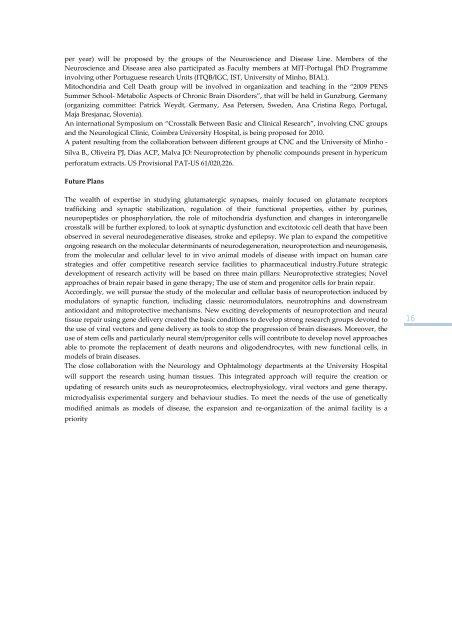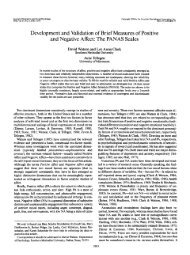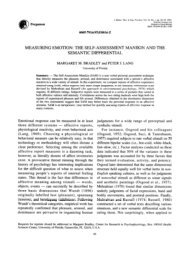Annual Report of Activities CNC 2008 - Center for Neuroscience and ...
Annual Report of Activities CNC 2008 - Center for Neuroscience and ...
Annual Report of Activities CNC 2008 - Center for Neuroscience and ...
Create successful ePaper yourself
Turn your PDF publications into a flip-book with our unique Google optimized e-Paper software.
per year) will be proposed by the groups <strong>of</strong> the <strong>Neuroscience</strong> <strong>and</strong> Disease Line. Members <strong>of</strong> the<strong>Neuroscience</strong> <strong>and</strong> Disease area also participated as Faculty members at MIT‐Portugal PhD Programmeinvolving other Portuguese research Units (ITQB/IGC, IST, University <strong>of</strong> Minho, BIAL).Mitochondria <strong>and</strong> Cell Death group will be involved in organization <strong>and</strong> teaching in the “2009 PENSSummer School‐ Metabolic Aspects <strong>of</strong> Chronic Brain Disorders”, that will be held in Gunzburg, Germany(organizing committee: Patrick Weydt, Germany, Asa Petersen, Sweden, Ana Cristina Rego, Portugal,Maja Bresjanac, Slovenia).An international Symposium on “Crosstalk Between Basic <strong>and</strong> Clinical Research”, involving <strong>CNC</strong> groups<strong>and</strong> the Neurological Clinic, Coimbra University Hospital, is being proposed <strong>for</strong> 2010.A patent resulting from the collaboration between different groups at <strong>CNC</strong> <strong>and</strong> the University <strong>of</strong> Minho ‐Silva B., Oliveira PJ, Dias ACP, Malva JO: Neuroprotection by phenolic compounds present in hypericumper<strong>for</strong>atum extracts. US Provisional PAT‐US 61/020,226.Future PlansThe wealth <strong>of</strong> expertise in studying glutamatergic synapses, mainly focused on glutamate receptorstrafficking <strong>and</strong> synaptic stabilization, regulation <strong>of</strong> their functional properties, either by purines,neuropeptides or phosphorylation, the role <strong>of</strong> mitochondria dysfunction <strong>and</strong> changes in interorganellecrosstalk will be further explored, to look at synaptic dysfunction <strong>and</strong> excitotoxic cell death that have beenobserved in several neurodegenerative diseases, stroke <strong>and</strong> epilepsy. We plan to exp<strong>and</strong> the competitiveongoing research on the molecular determinants <strong>of</strong> neurodegeneration, neuroprotection <strong>and</strong> neurogenesis,from the molecular <strong>and</strong> cellular level to in vivo animal models <strong>of</strong> disease with impact on human carestrategies <strong>and</strong> <strong>of</strong>fer competitive research service facilities to pharmaceutical industry.Future strategicdevelopment <strong>of</strong> research activity will be based on three main pillars: Neuroprotective strategies; Novelapproaches <strong>of</strong> brain repair based in gene therapy; The use <strong>of</strong> stem <strong>and</strong> progenitor cells <strong>for</strong> brain repair.Accordingly, we will pursue the study <strong>of</strong> the molecular <strong>and</strong> cellular basis <strong>of</strong> neuroprotection induced bymodulators <strong>of</strong> synaptic function, including classic neuromodulators, neurotrophins <strong>and</strong> downstreamantioxidant <strong>and</strong> mitoprotective mechanisms. New exciting developments <strong>of</strong> neuroprotection <strong>and</strong> neuraltissue repair using gene delivery created the basic conditions to develop strong research groups devoted tothe use <strong>of</strong> viral vectors <strong>and</strong> gene delivery as tools to stop the progression <strong>of</strong> brain diseases. Moreover, theuse <strong>of</strong> stem cells <strong>and</strong> particularly neural stem/progenitor cells will contribute to develop novel approachesable to promote the replacement <strong>of</strong> death neurons <strong>and</strong> oligodendrocytes, with new functional cells, inmodels <strong>of</strong> brain diseases.The close collaboration with the Neurology <strong>and</strong> Ophtalmology departments at the University Hospitalwill support the research using human tissues. This integrated approach will require the creation orupdating <strong>of</strong> research units such as neuroproteomics, electrophysiology, viral vectors <strong>and</strong> gene therapy,microdyalisis experimental surgery <strong>and</strong> behaviour studies. To meet the needs <strong>of</strong> the use <strong>of</strong> geneticallymodified animals as models <strong>of</strong> disease, the expansion <strong>and</strong> re‐organization <strong>of</strong> the animal facility is apriority16






